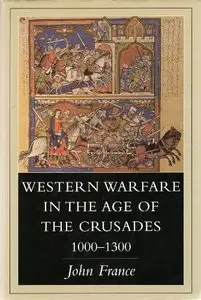Western Warfare in the Age of the Crusades 1000-1300 by John France
English | Jan 13, 1999 | ISBN: 0801486076, 0965870081 | 344 Pages | PDF | 2.7 MB
English | Jan 13, 1999 | ISBN: 0801486076, 0965870081 | 344 Pages | PDF | 2.7 MB
John France, as a military historian, may not have the recognition or popularity of an author such as John Keegan, but for the period of which he writes his work is no less valuable and perhaps more historically exact. This is a historical text, and those readers who have been attracted to the period by more popularizing authors such as Runciman may find this work, if more accurate, containing greater detail than sought. Nonetheless, this book is written with clarity and concision, and in this respect is an improvement over France's earlier and equally significant work "Victory in the East."
Revealing the largely proprietorial interests that motivated the warfare of this period, as well as the limited scope and ad hoc nature of its engagement, France does much to dismiss the formerly held image of early medieval warfare being epitomized by the massed charge of armored knights with lances couched. Not that such tactics did not occur, but more that warfare of the period was much more determined by circumstances that often precluded this practice's effectiveness, as well as the fact that much of the warfare of this period was predicated upon raiding and skirmishing in which military experience was based upon small conflicts and individual combat, where full-scale battle was more often than not eschewed in favor of limited engagements. And the social elements that influenced the makeup of a levy contributed to a decentralization of both leadership and constituency that often insured that when engaged, battle was hardly the set piece a tactician might envision. With the exception of household knights, most armies were composed of troops with varying degrees of training and experience, the former's loyalty tied to their individual lords, and the latter's reliability far from certain. With leadership based upon individual and often independent nobles of varying talent and experience whose value and ability to lead were often predicated upon notions of personal valor, the armies of this period were difficult to control and form, and their expected performance on the battlefield at best uncertain. Battle, when engaged, came about as often as not through accident, and could easily devolve into isolated islands of combat. Tight formation and precision of maneuvers were to wait until the more professional and standing armies of the 14th century, and it was not until this period that the massed charge of cavalry was to become standard. While at times this tactic was used effectively and with success–-most notably in the East–-during this period in Europe its use was often incidental and the results unpredictable. The use of siege and raiding were more often the norm.
This is an excellent book that offers far more than the comments above indicate. It examines not only the social, economic, political, and religious elements that contributed and informed the warfare of the period, but the armaments and changes in military practice–-slight in comparison to other periods they may be–-that defined warfare in the early Middle Ages. This book should be a must for any serious reader of the period.



